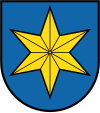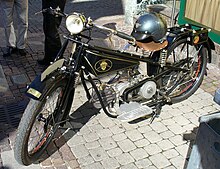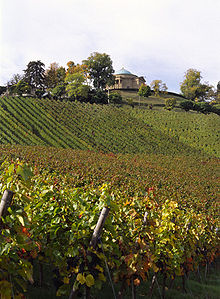Untertürkheim
|
Untertürkheim City district of the state capital Stuttgart |
|||||||||||||||||||||||||||||||||||||||||||
|---|---|---|---|---|---|---|---|---|---|---|---|---|---|---|---|---|---|---|---|---|---|---|---|---|---|---|---|---|---|---|---|---|---|---|---|---|---|---|---|---|---|---|---|
| District coat of arms | City map | ||||||||||||||||||||||||||||||||||||||||||

|
|||||||||||||||||||||||||||||||||||||||||||
| List of districts of Stuttgart | |||||||||||||||||||||||||||||||||||||||||||
| Incorporation : | Untertürkheim April 1, 1905 Rotenberg May 1, 1931 |
||||||||||||||||||||||||||||||||||||||||||
| Height : | 225- 411 m above sea level. NHN | ||||||||||||||||||||||||||||||||||||||||||
| Population density : | 2,757 inhabitants per km² | ||||||||||||||||||||||||||||||||||||||||||
| Postal code : | 70327 | ||||||||||||||||||||||||||||||||||||||||||
| Area code : | 0711 | ||||||||||||||||||||||||||||||||||||||||||
| Address of the district town hall: |
Grossglocknerstrasse 24 70327 Stuttgart |
||||||||||||||||||||||||||||||||||||||||||
| Website: | www.stuttgart.de | ||||||||||||||||||||||||||||||||||||||||||
| District Head: | Dagmar Wenzel | ||||||||||||||||||||||||||||||||||||||||||
|
|||||||||||||||||||||||||||||||||||||||||||
| (1) 666 Bruckwiesen is included in 665 Lindenschulviertel | |||||||||||||||||||||||||||||||||||||||||||
| Transport links | |||||||||||||||||||||||||||||||||||||||||||
| Federal road |
|
||||||||||||||||||||||||||||||||||||||||||
| Regional train | R 11 | ||||||||||||||||||||||||||||||||||||||||||
| Train | S 1 | ||||||||||||||||||||||||||||||||||||||||||
| Light rail | U 4 U 13 | ||||||||||||||||||||||||||||||||||||||||||
| bus | 60, 61 | ||||||||||||||||||||||||||||||||||||||||||
| Source: Stuttgart data compass | |||||||||||||||||||||||||||||||||||||||||||
Coordinates: 48 ° 47 ' N , 9 ° 15' E
Untertürkheim is one of the districts of Stuttgart located directly on the Neckar , surrounded by Obertürkheim , Wangen , Bad Cannstatt and the neighboring community of Fellbach .
See also Luginsland and Rotenberg .
history

Untertürkheim was first mentioned in 1121 as Durinkheim . The name probably goes back to an Alemannic chief in the 4th century. The place * Duringoheim was named after this. The name in today's dialect is (Onder-) Dürkna .
In the High Middle Ages, Untertürkheim belonged to the Duchy of Swabia and, after its dissolution, became a core component of Old Wuerttemberg . Due to its location on the river, the Neckar rafting company used to be an important source of income. Next to it was and is the wine due to the exposure of the Neckar valley slopes in Untertürkheim important. Numerous wine-growing businesses (some with broom taverns ) and two cooperative wine producers are located in Untertürkheim ( Untertürkheim Wine Manufactory ) and in Rotenberg.
In 1449, Untertürkheim was devastated by troops from the imperial city of Esslingen . In the Thirty Years' War, after the devastating defeat for the Heilbronn Bund in the Battle of Nördlingen , when the Duchy of Württemberg was defenselessly surrendered to the Imperial Army from 1634 , 240 buildings in Untertürkheim were burned down.
During the administrative reform of the Kingdom of Württemberg at the beginning of the 19th century, Untertürkheim remained assigned to the Cannstatt Oberamt and thus belonged to the Neckar District from 1818 . On October 22, 1845, the first Württemberg railway ran on the section of the Zentralbahn from Cannstatt to Untertürkheim.
The scheduled tram operation and thus the connection to the Stuttgart tram network took place on November 26, 1910 with line 15 from Schlossplatz via Wangen to the Untertürkheim Neckar Bridge.
industrialization
In 1889, the bed spring factory Straus & Cie. from Cannstatt their production facility in Untertürkheim. The Jewish owners were forcibly expropriated in 1938 and the world's largest bed spring company was dissolved.
In 1898 the cocoa and chocolate factory Staengel & Ziller, founded by Ernst Staengel in Stuttgart in 1857 - the name " Eszet " arose from the initials - moved to Untertürkheim. The famous Eszet wafers were produced here from 1933 . They have been manufactured by the Cologne-based Stollwerck Group since 1975 , Staengel & Ziller no longer exists.
Thanks to the negotiating skills of the mayor Eduard Fiechtner from Untertürkheim and Gottlieb Daimler , a purchase agreement was concluded with the Daimler-Motoren-Gesellschaft in 1900 . As early as 1903, the automobile factory set up shop in Untertürkheim, as its engine factory in the neighboring city of Cannstatt had burned down, making it the second production facility of the Daimler-Motoren-Gesellschaft. The headquarters of Daimler AG have been here again since April 2006 .
In 1902 the United Seifenfabriken Stuttgart acquired Wasengelände near the Untertürkheim train station and had the architect Philipp Jakob Manz build large buildings for the soap boilers. Until 1933 the “Feurio” soap was produced in Untertürkheim, among others. The buildings were then sold to Daimler-Benz .
The company Eugen Bauer GmbH , known as "Kino-Bauer" , once the world's largest manufacturer of amateur and cinema film projectors, founded in 1907 by Eugen Bauer in Stuttgart, has been producing since 1928 in Untertürkheim opposite the train station. In 1932, Bauer was taken over by Robert Bosch GmbH (“Bosch Photo Cinema”), and in the early 1980s the production of film projectors was also discontinued, and in 1992 the photo cinema product area was completely dissolved.
The company Fahrzeugbau Hurst of Arthur Friedrich Hurst from Stuttgart began in 1946 with the production of "Hurst 250" automobiles . Production began in Untertürkheim in the summer of 1949. At the beginning of 1950 vehicle production was stopped after 47 copies.
On March 31, 1958, the port of Stuttgart was opened by Federal President Theodor Heuss . The northeastern part of the Neckar port (oil port) belongs to Untertürkheim.
Incorporation to Stuttgart
The Weingärtnerort was incorporated into Stuttgart on April 1, 1905 together with Cannstatt and Wangen .
When the city of Stuttgart was divided into districts in 1956, the Untertürkheim district was combined with the Luginsland district and the Rotenberg district, which was incorporated on May 1, 1931, to form the new Untertürkheim district .
When the Stuttgart districts were restructured on January 1, 2001, the Untertürkheim district was divided into the Benzviertel , Bruckwiesen , Flohberg , Gehrenwald , Lindenschulviertel and Untertürkheim districts. Since then, the town hall in Untertürkheim has managed a total of eight districts in the Untertürkheim district.
Urban facilities
schools
There are five schools on site: the Auschule (special needs school), the Linden Realschule, the Luginslandschule (elementary and secondary school), the Wilhelmsschule (elementary school) and the Wirtemberg grammar school .
Baths
- The municipal swimming pool Untertürkheim (indoor swimming pool) is operated by a support association.
- The listed "swimming stadium" Inselbad Untertürkheim ( outdoor pool on a Neckar island ) was built in 1927-29 on behalf of the city of Stuttgart by the architects Paul Bonatz and Friedrich Eugen Scholer for the 15th German Gymnastics Festival in 1933.
Culture and sights
Sepulcher chapel on the Württemberg in Rotenberg
- The Evangelical City Church of St. Germanus was built in 1478, but was mentioned in a document as early as 1289. According to a chronicler, the church was built as a thank you for some very fruitful years and led to Untertürkheim becoming an independent parish. The remarkable altar wall "Josefslegende" by the sculptor HAP Grieshaber has been there since 1970 .
- The Catholic Church from 1903 is dedicated to John the Evangelist. The Schefold organ in St. Johannes Church was named " Monument of the Month December 2004" by the Baden-Württemberg Monument Foundation.
- The grave chapel on the Württemberg of the Württemberg King Wilhelm I for his second wife Katharina Pawlowna on the Württemberg in Rotenberg .
- The kindergarten "Schiff im Weinberg" , built in 1990 by architect Günter Behnisch in Luginsland .
- The Evangelical Church in Rotenberg, a Swabian baroque village church with an onion dome from 1754.
- The longest bridge combination in Stuttgart, the 1400 meter long Neckar Valley Viaduct Untertürkheim crosses the Untertürkheim freight station at a height of 20 meters, the Daimler premises and the Neckar to the wholesale market in Stuttgart-Wangen .
- The Wilhelmsbrunnen by Karl Bruder, built in 1905 for incorporation in Art Nouveau style, resembles Vienna's Strudlhofstiege
- The Untertürkheimer Altenberg , see also viticulture in Stuttgart , Württemberg (wine-growing region) , Gault-Millau and Württemberger Weinstrasse .
- Since 1989, a memorial by the sculptor Bernhard Heiliger on the company premises of the Mercedes-Benz plant in Untertürkheim has been commemorating the around 20,000 forced laborers from numerous countries who were deported to Germany during the Second World War and forced into forced labor in the various companies of the company.
- A memorial plaque on house 6 Annastraße in the Luginsland workers' settlement , which was installed by IG Metall in 1969, commemorates the anti-fascist resistance of the Schlotterbeck family . After almost the entire family was murdered in Dachau concentration camp in 1944 , they have been commemorated with a memorial in the cemetery since 1949 .
- The first municipal water and steam power plant in Württemberg was opened from 1899 to 1902 on the dammed Neckar opposite the Untertürkheim train station. Even after the Neckar was relocated in 1923, the power plant is still in operation and connected to the Neckar by a canal.
- The Untertürkheim barrage has been in the Neckar since 1923 ; the 110-meter double-chamber lock was added to the port opening in 1958, which has been used for inland shipping since then.
- The Untertürkheimer Rundwanderweg II is a 12 kilometer long hiking trail that leads past the burial chapel and the Kappelberg .
- The Im Wallmer workers' settlement , which dates back to the interwar period and is a listed building as a whole
media
Untertürkheim has had its own daily newspaper , the Untertürkheimer Zeitung, since 1899 . Today it cooperates as a local edition in Stuttgart with the Cannstatter Zeitung and the Eßlinger Zeitung in the Bechtle publishing house.
politics
District Advisory Board
|
Local elections 2019
% 30th 20th 10
0
23.9
20.3
13.5
10.2
7.5
6.3
4.7
3.0
10.5
Gains and losses
Due to the number of inhabitants in the district, the Untertürkheim District Advisory Board has 11 full and just as many deputy members. The following distribution of seats has been in effect since the last local elections in 2019:
|
Schultheißen before 1905
- Johann Friedrich Lindenfels, bailiff from 1676
- Ludwig Jakob Biklen, bailiff
- Georg Wilhelm Brodbeck
- Carl Mäulen, 1846 to September 30, 1879
- Eduard Fiechtner , October 1, 1879 to April 30, 1905
District Head
- Karl Weber, 1946 to 1954
- Jakob Mangold, 1954 to December 31, 1970
- Rudolf Rehm, January 1, 1971 to September 30, 1989
- Klaus Eggert, October 4, 1989 to September 30, 2014
- Dagmar Wenzel, October 1, 2014
Personalities
Honorary citizen
- Eduard Fiechtner , (1843–1922), mayor, was granted honorary citizenship of the community of Untertürkheim on October 1, 1904 for the twenty-five year jubilee in office. He was instrumental in signing the purchase agreement with Daimler-Motoren-Gesellschaft for the construction site for their new engine plant in Untertürkheim in 1900 .
- In 1926 Alexander Beutter (1862–1952), pastor and music scholar, received honorary citizenship of the Rotenberg community.
Born in Untertürkheim
- Johann Friedrich LeBret (born November 19, 1732 in Untertürkheim; † April 6, 1807 in Tübingen ), was a theologian, professor at the High Charles School and Chancellor of the University of Tübingen
- Hermann Brodbeck (born July 10, 1849 in Untertürkheim, † April 1, 1912 in Eßlingen ), member of the Reichstag and state parliament
- Hermann Zaiss (born September 3, 1889 in Untertürkheim, † November 14, 1958) was one of the most important German healing evangelists.
- Hermann Scheihing opened in 1922 in Untertürkheim a mechanical workshop, from which the company "(† 31 May 1934 born June 15, 1890 in Untertürkheim) UT engine and vehicle " emerged that there until 1926, the motorcycles of the brand "UT “Produced.
- Eugen Maier (born November 13, 1899 in Untertürkheim, † January 16, 1940 in Ulm) politician (NSDAP), member of the state parliament
- Helmut Bornefeld (born December 14, 1906 in Stuttgart-Untertürkheim; † February 11, 1990 in Heidenheim an der Brenz ) Protestant church musician, composer, organ expert, graphic artist and author.
- Klaus-Georg Hengstberger (born March 9, 1930 in Stuttgart-Untertürkheim), managing director, local politician
- Helmut Palmer (born May 8, 1930 in Stuttgart-Untertürkheim; † December 24, 2004 in Tübingen), described himself as a civil rights activist and pomologist .
- Horst Schwarz (born July 12, 1942 in Stuttgart-Untertürkheim), former German wrestler.
Other personalities
- Johann Ulrich Pregizer IV. (* April 7, 1673 in Tübingen ; † January 13, 1730 in Untertürkheim) was a theologian and historian in Nürtingen and Untertürkheim
- Johann Christian Pfister (born March 11, 1772 in Pleidelsheim ; † September 30, 1835 in Stuttgart), general superintendent, prelate, historian, friend of Schelling's, was pastor in Untertürkheim from 1813 to 1832
- Johann Wilhelm Braun , (born November 29, 1796 in Stuttgart, † April 26, 1863 in Untertürkheim) was the sculptor and creator of the Etzel monument on the Neue Weinsteige
- Karl Ludwig Elsässer , (born April 13, 1808 in Neuenstadt / Linde, † March 7, 1874 in Untertürkheim), was a doctor and senior medical officer a. a. with Eduard Mörike
- Albert Dulk (1819–1884), free thinker and writer, lived in Untertürkheim for a long time
- Christian Lautenschlager (born April 13, 1877 in Magstadt ; † January 3, 1954 in Stuttgart-Untertürkheim) was a racing driver and winner of the French Grand Prix in 1908
- Hermann Brodbeck (* 1889; † April 17, 1973 in Stuttgart-Untertürkheim) was a successful wrestler
- Fritz Stange (born September 20, 1936 in Ludwigsburg; † August 4, 2013 in Stuttgart) was a German wrestler, world and European champion in 1966 (as a member of the Untertürkheimer Kraftsportverein)
- Bruno Dobelmann , nickname "Orca", (born January 18, 1959 in Hutthurm) is a German extreme swimmer
Sports
- With the sports community 07 Untertürkheim , a former first and second class football club has its headquarters in the city district. Founded in 1907, the club under the old name SpVgg Untertürkheim was first class as a Gauligist from 1940 to 1941 and from 1944 to 1945 . After 1945 the SG 07 played in the first second, later third, now sixth class amateur league Württemberg .
- With its 1,600 members, the Turnerbund Untertürkheim e. V. founded in 1888/99, the largest sports club in Untertürkheim. The club house with the club's own stadium is located in Gewann Gehrenwald.
Population development
| Transport links | |
|---|---|
|
|
|
|
|
|
|
S 1 ( Kirchheim / Teck - Stuttgart - Herrenberg ) R 11 "Schusterbahn" to Kornwestheim |
|
|
U 4 (Untertürkheim - Charlottenplatz - Hölderlinplatz) U 13 (Feuerbach-Bad Cannstatt-Hedelfingen) BUS 60
(via Luginsland to Fellbach ) |
|
 Untertürkheim railway station 1898 |
(Sources: Heimatbuch Untertürkheim and Rotenberg, 1985 and Statistical Office of the City of Stuttgart)
| year | Untertürkheim | Rotenberg | Borough |
|---|---|---|---|
| 1834 | 1,861 | 505 | |
| 1852 | 2,308 | 527 | |
| 1871 | 2,755 | 499 | |
| 1900 | 4,954 | 545 | |
| 1905 | 6,761 | 583 | |
| 1925 | 9,455 | 652 | |
| 1933 | 12,009 | 645 | |
| 1946 | 14,296 | 710 | |
| 1950 | 17,210 | 807 | |
| 1961 | 18,482 | 985 | 19,467 |
| 1970 | 18,031 | 1,059 | 19,090 |
| 1980 | 16,183 | 933 | 17,116 |
| 1990 | 16,658 | ||
| 2000 | 16,027 | ||
| 2005 | 15,663 | 789 | 16,452 |
| 2007 | 15,653 | 781 | 16,434 |
| 2009 | 15,736 | 754 | 16,490 |
| 2011 | 15,157 | 719 | 15,876 |
| 2014 | 15,619 | 749 | 16,368 |
Regular events
In addition to the numerous pockets of the local clubs, the "Long Red Wine Night" is celebrated by candlelight every two years in the pedestrian zone in mid-June. On the last Sunday in July, thousands of visitors hike through the Untertürkheim vineyards on the “Untertürkheim Wine Tour”. On the penultimate Sunday in October, the trade presents itself at the “Fleggatreff”, which is open for sale, and ends with the Christmas market on the 2nd Saturday in Advent.
Literature / homeland books
- Keinath, Johannes: Untertürkheimer Heimatbuch, Stuttgart, Deutsche Verlagsanstalt 1935, published on behalf of the Untertürkheim Citizens' Association
- Brother, Hermann: Untertürkheim and Rotenberg. The heart of the Swabian region. A home book. Stuttgart: Self-published by the Untertürkheim Citizens' Association (1983)
Web links
- Unter-Türkheim in the description of the Upper Office Canstatt 1832
- Description of the location of Untertürkheim 1895
- Untertürkheim portal with a tour of the town
- Untertürkheim civic association with local museum in Rotenberg
Individual evidence
- ^ Stuttgart.de: Untertürkheim. Retrieved July 29, 2019 .
- ^ Collegium Wirtemberg
- ↑ Memorial sites for the victims of National Socialism. A documentation, volume 1. Federal Agency for Civic Education, Bonn 1995, ISBN 3-89331-208-0 , p. 90.
- ↑ https://statistik.stuttgart.de/wahlen/app/gw2019.html


















